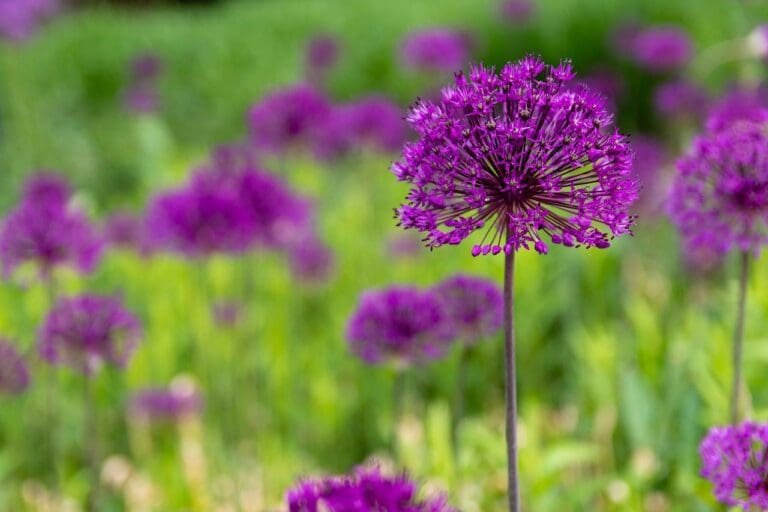The sight of cheerful crocuses emerging from the ground in early spring is one of the first signs that winter is coming to an end. With their vibrant yellow, purple, and white blooms, these hardy flowers are harbingers that warmer and longer days are on their way.
If you want to welcome spring with a splash of colour in your garden, learning how to grow crocuses is easy. These small bulbs require minimal care but deliver an outsized visual impact when they blanket the ground with their delicate blossoms.
In this comprehensive guide, you’ll discover how to choose the right crocus varieties, prepare the planting site, plant the corms properly, and care for crocuses so you can enjoy their beauty year after year.
You might also be interested in: Spring Flowering Bulbs
Choosing the Right Crocus Varieties for Your Garden
With dozens of crocus species and countless hybrids, there are many options to choose from. The most popular types of crocuses for gardens include:
- Crocus vernus – Blooms in early spring in shades of purple, yellow, white. Grow in sun.
- Crocus chrysanthus – Blooms early to mid-spring in yellow, white, purple. Tolerates shade.
- Crocus sieberi – Blooms early spring with pale purple flowers marked with darker veins. Prefers sun.
- Dutch crocus hybrids – Large, vivid flowers in spring. ‘Remembrance’ is a popular purple variety. Grow in sun.
- Snow crocus – White flowers bloom early spring. Tolerates light shade.
Choose crocus corms based on bloom time, flower colour, and sunlight requirements that match your garden’s conditions. Plant a combination of varieties together to create a longer flowering season.
Preparing the Planting Site for Crocus Bulbs
Proper soil preparation is key to successfully growing crocuses. They require well-drained soil and will rot if planted in wet, soggy conditions. Follow these tips to get the planting area ready:
- Test the soil pH and amend with lime if needed to reach a neutral pH around 7.0.
- Loosen compacted soil and mix in compost or other organic matter to improve drainage.
- Choose a site with full sun to light shade. At least 6 hours of sun is ideal.
- For lawns, remove a chunk of sod and enrich the soil underneath before planting crocus corms.
- In gardens, select a spot near the front of flower beds so the low-growing crocuses are visible.
- Improve drainage by planting on mounded soil and avoiding low spots where water collects.
Preparing the site properly goes a long way towards ensuring the crocuses thrive and put on the best floral display possible.
Planting Crocus Corms for Spring Blooms
One of the easiest parts of growing crocuses is planting the corms (bulbs) in autumn for gorgeous spring blossoms. Here are the key steps:
- Purchase large, firm corms from a reputable supplier and plant as soon as possible after receiving them.
- Plant crocus corms in autumn, any time between late September and early December.
- Dig holes or trenches 3 to 4 inches deep. Space corms 3 to 6 inches apart.
- Place corms pointy side up in holes and cover with soil. Pat down gently but avoid packing tightly.
- Water thoroughly after planting to settle soil and stimulate root growth.
- Consider planting in drifts or clusters for greater visual impact rather than single rows.
- Mix different crocus varieties together for a colourful, extended bloom season.
- Add a thin layer of mulch such as chopped leaves or straw to insulate planted crocus corms from harsh winter cold.
Proper planting depth and spacing will lead to a fabulous crocus display in your garden next spring.
Caring for Crocuses Throughout the Seasons
One of the easiest spring bulbs, crocuses require minimal maintenance to thrive. Follow these seasonal care tips:
Spring:
- Water sparingly if rainfall is lacking while blooms are present.
- Allow foliage to die back naturally; don’t cut leaves until they yellow completely.
- Fertilize after blooming if you wish using a balanced organic fertilizer.
Summer:
- Allow crocus plants to remain dormant and don’t water.
- Keep weeds pulled to prevent crowding dormant corms.
Autumn:
- Divide overcrowded crocus clumps every 2-3 years after foliage dies back.
- Plant new corms promptly in prepared soil in early autumn.
Winter:
- Mulch planted crocus corms with a light organic material for insulation if you experience harsh winters. Avoid excessive mulching.
- Water newly planted corms if the ground freezes before rain can penetrate deeply.
Proper watering, occasional fertilizing, weeding, and mulching are the keys to keeping crocuses healthy and blooming successfully year after year.
Creative Ways to Showcase Crocuses in Your Garden
Beyond planting swathes of crocuses in lawns and beds, there are many creative ways to highlight these flowers:
- Underplant crocuses with dwarf daffodils or early tulips to extend the spring bulb show.
- Plant pocket drifts of crocuses in rock gardens and alpine tiers.
- Surround crocuses with low-growing groundcovers like ajuga, thyme, or creeping phlox.
- Allow crocuses to naturalize in lawn grass for a temporary carpet of colour.
- Use crocuses along borders, pathways, and driveway edges for a cheerful welcome.
- Tuck corms into gaps between established perennials, roses, and shrubs.
- Plant mini drifts of crocuses in containers on patios and entryways.
With their vibrant hues and delicate forms, crocuses look beautiful when allowed to spread naturally in lawns or planted en masse along gardens and walks. Usher in spring with these cold-tolerant bulbs!
Frequently Asked Questions About Growing Crocuses
What is the best time to plant crocus corms?
The ideal time for planting crocus bulbs is in early autumn, anytime from late September through November. This allows their roots to establish before the ground freezes.
Can I grow crocuses in pots?
Yes, crocuses look lovely when potted in containers. Choose shallow planters and use a well-draining potting mix. Bring pots indoors to a cool location once they finish blooming to keep bulbs dormant for replanting.
How long do crocuses bloom?
Depending on the variety, crocus flowers last 1-2 weeks in early spring if weather conditions are optimal. Planting different types together extends the overall bloom period.
How do I care for crocuses after they have bloomed?
Allow the foliage of crocuses to die back completely before removing it. This allows the bulbs to recharge for the following year. Avoid cutting leaves until they yellow.
Are crocuses deer resistant?
Deer tend to avoid crocuses, especially types that are more pungently fragrant. Plant crocuses near vulnerable flowers to potentially distract browsing deer.
Welcome Spring With Cheerful Crocuses
Ready to greet spring with a burst of colourful crocuses? Now that you know how to select bulbs, prepare the planting site, properly plant the corms, and care for them seasonally, you can successfully grow these hardy flowers.
Make room for crocuses in flower beds, along walkways, and allowed to naturalize in lawns for a cheerful display. Their bright blooms will be a sure sign that cold winter days are over and the garden is springing back to life.



